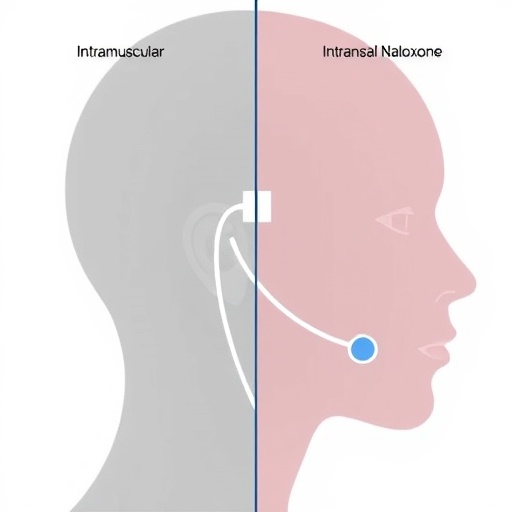
In the ongoing battle against the devastating opioid epidemic, a new study published in Nature Communications shines a spotlight on an urgent clinical question: which naloxone formulation is more effective in reversing the lethal respiratory depression caused by fentanyl overdoses? This groundbreaking randomized, crossover, open-label trial conducted by van Lemmen, van Velzen, Sarton, and colleagues comprehensively compares the efficacy of intramuscular naloxone (commercially known as Zimhi) against its widely used intranasal counterpart, Narcan. The insights from this research hold immense potential to reshape emergency response protocols and potentially save thousands of lives worldwide as fentanyl and its analogs continue to fuel overdose fatalities.
Fentanyl-induced apnea, a condition marked by the cessation of breathing, represents one of the most life-threatening manifestations of opioid toxicity. Due to fentanyl’s exceptionally high potency—estimated to be 50 to 100 times stronger than morphine—standard naloxone administration techniques have been widely scrutinized for their rapidity and reliability in restoring spontaneous respiration. Naloxone itself functions as a potent opioid antagonist, competitively binding to opioid receptors and displacing fentanyl molecules to reverse respiratory depression. However, the drug’s pharmacokinetics, delivery route, and onset velocity are critical factors in determining its efficacy in real-world overdose scenarios.
The study recruited a cohort of volunteers to undergo a crossover comparison, where each participant received both intramuscular and intranasal naloxone in separate sessions after controlled fentanyl administration. This design allowed direct head-to-head evaluation of both routes without confounding variables such as interindividual variability. Importantly, the open-label nature of the trial, while limiting blinding, ensured practical assessment of administration techniques under conditions resembling emergency use. The primary endpoint focused on measuring the time to restoration of adequate breathing function post-naloxone administration, an essential clinical marker of reversal success.
Intramuscular injection with Zimhi proved to act with remarkable speed, consistently initiating respiratory recovery within minutes. Pharmacodynamically, the intramuscular route offers rapid systemic absorption via the richly vascularized muscle tissue, leading to prompt achievement of therapeutic plasma concentrations. In contrast, while intranasal Narcan offers the advantage of needle-free delivery crucial for layperson administration, this trial revealed a somewhat delayed onset of action compared to Zimhi. Nasal mucosa absorption, although well-vascularized, can be hindered by factors such as nasal congestion, mucosal variability, and spray device delivery efficiency.
Beyond the onset times, the trial also examined the sustainability of naloxone’s antagonistic impact on fentanyl. The prolonged half-life of fentanyl compared to naloxone necessitates careful consideration of whether a single dose suffices or if repeated administration is warranted. The intramuscular formulation, by maintaining effective plasma levels longer, may reduce the risk of renarcotization—where opioid toxicity reemerges after initial reversal. Conversely, intranasal naloxone’s shorter duration may require multiple doses, complicating emergency intervention.
This direct comparative analysis gains even greater significance when contextualized within the urgent public health crisis posed by synthetic opioids. Fentanyl’s rapid onset and extreme potency render delays in naloxone administration frequently fatal. First responders, emergency medical services, and even bystanders equipped with naloxone kits can benefit from data-driven guidelines optimizing which formulation to deploy. The trade-off between ease of use for intranasal sprays and speed of action with intramuscular injections could be a pivotal decision factor in life-saving efforts.
The clinical implications of this research extend beyond pharmacokinetics. Intramuscular naloxone administration requires training for injections and carries risk factors such as needle-stick injuries, which are barriers to widespread community use. Intranasal delivery, by contrast, circumvents these challenges, enabling broader distribution and empowering non-medical rescuers. However, this trial’s evidence demands a reassessment of how public health agencies balance immediacy of response with feasibility of administration, especially in high-risk fentanyl exposure settings.
Moreover, the physiological underpinning of naloxone’s antagonism reveals critical insights into opioid receptor dynamics. By competitively binding predominantly at the mu-opioid receptor subtype, naloxone rapidly reverses respiratory depression but may precipitate acute withdrawal symptoms. This delicate interplay necessitates precise dosing and delivery methods to maximize survival while minimizing adverse events post-intervention. The present study meticulously monitors such parameters, ensuring a holistic evaluation of each formulation’s benefit-risk profile.
Intriguingly, the crossover design employed in this trial is pivotal for eliminating intersubject variability—a frequent confounder in pharmacologic studies. Each participant essentially served as their own control, enhancing internal validity and lending robustness to the conclusions drawn. This methodological rigor bolsters confidence that observed differences in time to respiratory recovery stem directly from the route of naloxone administration rather than extraneous biological differences among individuals.
Safety outcomes reported in the study confirm that both intramuscular and intranasal naloxone maintain commendable tolerability, with adverse events primarily confined to mild injection site discomfort or transient nasal irritation. This reassuring safety profile supports continued reliance on naloxone as an indispensable tool in opioid overdose management.
The implications of this work also reach into policy and accessibility domains. As governmental and non-governmental organizations scale naloxone distribution programs, understanding the nuances between different delivery mechanisms could guide procurement decisions and training curricula. Prioritizing intramuscular naloxone for paramedics and medical professionals while promoting intranasal sprays for layperson use might optimize overall survival outcomes.
Further research building upon these findings could explore combination approaches, novel delivery devices, or adjunct therapies that synergize with naloxone’s opioid reversal properties. The evolving landscape of synthetic opioid analogs also underscores the necessity of adaptable treatment protocols that can address varying receptor binding affinities and overdose severities.
In conclusion, this seminal trial by van Lemmen and colleagues offers compelling evidence that intramuscular naloxone administration leads to faster and potentially more sustained reversal of fentanyl-induced apnea compared to intranasal delivery. While the needle-free convenience of intranasal sprays remains valuable for community-based interventions, the enhanced pharmacokinetic profile of intramuscular formulations positions them as critical in high-acuity medical responses. These insights guide clinicians, responders, and public health policymakers in refining overdose response strategies amid the intensifying synthetic opioid crisis.
As fentanyl continues to threaten global health, integrating rigorous scientific evaluation such as this into clinical guidelines ensures that every second counts when reversing deadly respiratory arrest. With naloxone standing as a frontline antidote, optimizing its delivery will undeniably save countless lives. This study’s comprehensive and methodical approach sets a new benchmark for opioid overdose treatment research, catalyzing further innovation and ultimately fostering hope in the face of a catastrophic epidemic.
Subject of Research: Comparison of intramuscular (Zimhi) and intranasal naloxone (Narcan) in reversal of fentanyl-induced respiratory depression.
Article Title: A comparison of intramuscular (Zimhi) and intranasal naloxone (Narcan) in reversal of fentanyl-induced apnea: a randomized, crossover, open-label trial.
Article References: van Lemmen, M.A., van Velzen, M., Sarton, E.Y. et al. A comparison of intramuscular (Zimhi) and intranasal naloxone (Narcan) in reversal of fentanyl-induced apnea: a randomized, crossover, open-label trial. Nat Commun 16, 4659 (2025). https://doi.org/10.1038/s41467-025-59932-7
Image Credits: AI Generated
Tags: emergency response protocolsfentanyl apnea managementfentanyl epidemic solutionsfentanyl overdose treatmentintramuscular naloxone efficacyintranasal naloxone comparisonlife-saving drug administrationnaloxone delivery methodsnaloxone pharmacokineticsopioid antagonist effectivenessopioid respiratory depression reversalrandomized crossover trial naloxone




